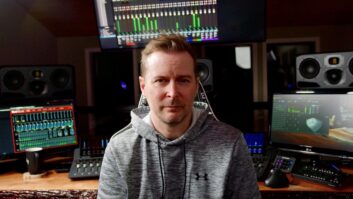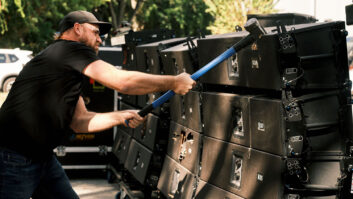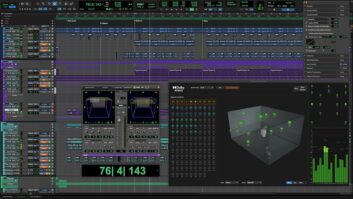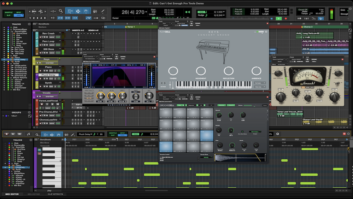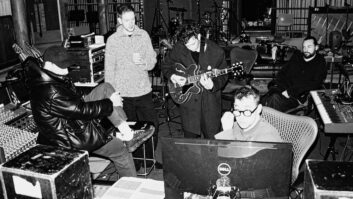Long, long ago, in a simpler place and time, audio “storage” meant finding a dark, dry, cool place to park those 2-inch and ¼-inch tape boxes after a project was released. Backups were of little concern, as an analog “safety copy” was a compromised duplicate with increased noise. With the advent of digital recorders in the early ’80s, clone tapes of digital multitrack sessions became a reality and older masters could be archived to a “safe” medium with no generational loss.
However, some 20 years after those first digital multitracks appeared, dealing with masters is no picnic. Over time, many beloved analog tapes fell victim to “sticky-shed syndrome,” making them unplayable unless heated to 135 degrees or so for several hours. Although this was hardly a cure, if conditions were right, it might provide for a least one playback — this time, hopefully to a safer, archiveable medium. Now, those long-discontinued digital multitracks provide a new quirk: Finding a working vintage digital playback machine is difficult — ask anyone who requires a 3M 32-track or Akai A-DAM deck.
The rise of disk-based recording systems simplifies creating backup copies, especially with plummeting media costs and affordable, high-capacity hard disks. Yet we’re hardly out of the woods. As the wheels of progress turn, formats/media from just a few years back may have vanished. Drives for yesterday’s removable media — whether Bernoulli or Jaz drives or 5.25/3.5-inch floppies — are scarce. Even the venerable SCSI port — the standard for so long — has nearly disappeared from today’s computers.
With endless storage options and file formats for modern DAWs, archiving multitrack master tapes for future playback is a complex issue, compounded by rapid changes in storage media and the fragile nature of data that is stored on such systems. Dropping an analog tape to the floor may result in a bent reel flange, while the same action with a hard drive spells disaster. Disk failures are subject to the “not if, but when” rule, making data backups an essential part of audio production.
“The problem is huge,” says Maureen Droney, the new head of the Recording Academy’s Producers & Engineers Wing. A forward-thinking committee of audio-minded P&E members — headed by co-chairs Kyle Lehning and George Massenburg — began drafting “The Delivery Recommendations for Master Recordings.” This exhaustive 27-page document (available at www.grammy.com/pe_wing) offers advice for short- and long-term master storage. Suggestions include the need to store DAW recordings as consolidated/flattened (no gaps between track segments) individual tracks in the Broadcast .WAV file format at 24-bit (or higher) resolution and sample rate at/above the master recording. Following this procedure, a multitrack project could be reassembled — regardless of the software or DAW program used on the original.
Yet even with such guidelines available, proper storage and backup in the music industry is often elusive. We spoke to a number of industry pros with expertise in differing aspects of the storage issue. As one might expect, this led to some answers — and more questions.
DISKS AND DATA
“Hard disks have become the new tape,” says Steve Smith, an industry veteran who is now the president of Avastor, a company that markets data storage solutions to the audio and video industries. Despite being a supplier of high-performance drives, Smith is realistic about disk technology: “There’s no middle ground. When a hard disk doesn’t work, it really doesn’t work. Drive failures are rare, but the alternative to not backing up in those cases is a drive data recovery service. Those guys are good at what they do, but often the price starts around $2,000 for one drive. It’s not as cheap as baking a tape.”
Ironically, like baking tapes, damaged drives have their own folk-style remedies. Long-term storage of a hard drive is not recommended unless the drive is “exercised” on a regular basis. “Almost everyone I’ve talked to who archives drives has said that after two or three years of sitting without spinning, some drives will tend not to spin. There’s a possible cheap fix for this,” Smith explains, “which is the opposite of baking a tape: You freeze a drive that won’t spin up and then spin it up while it’s cold — right out of the freezer. I haven’t tried it, but the Internet is full of stories of those who have tried it with complete success.
“Most of the labels we’ve been working with are using a combination of FireWire 400- or 800Mbps drives. The most popular capacity being 160 GB, but lately, 250 GB has become almost as popular. Now we’re selling lots of the new 500GB single drives. For longer-term storage, some people use data tape for archiving, mostly 8mm AIT and VXA [Exabyte] in audio. In very long-term storage, tape is still the way to go, but with AIT2 and VXA only having capacities from 30 to 80 GB per tape, backing up to tape can be time-consuming.”
Smith does offer some practical advice: “I recommend reformatting a drive anytime you begin a project on a drive that’s new, one you’re unsure about or when you’re reusing a drive.” Less well-known is the “misnomer of ‘plug-and-play’ or ‘hot-swappable’ drives with FireWire,” Smith continues. “It’s is a real issue. You can plug and unplug a ‘hot’ FireWire cable and have no problems 100 times, but on the next time, you could possibly have a problem from shorting the bus power by inserting the plug at a slight angle. I actually smoked a circuit board on a drive once by doing that. It’s rare, but good practice would be to plug in all your FireWire devices before powering up.”
SERIOUS ABOUT BACKUPS
Engineer/producer Mark Needham — whose credits range from Chris Isaak to The Killers, and Flipper to Fleetwood Mac — recently completed The Ballroom, his private facility built into a old ballroom in Hollywood. With a steady stream of label projects coming in, Needham needed a flexible network to serve his storage and backup needs.
“I have two rooms at my studio: One is a mix room, the other is an edit room where I do all my pre-editing, and they’re both connected to one central server,” he says. “Having access to both the edit and mix rooms working on the same project has saved me a lot of time. I got the system from RSPE Audio Solutions and they contracted it out to Michael Dorian of MD Productions, who set up a fiber-optic-to-SATA RAID storage system with a 3.2-Terabyte server.” One computer handles backups via a tape backup system with an eight-tape Exabyte tape library that automatically backs up everything continually from all four computers.
“We can be working on the same song from the same drive and everything’s backed up. If we were just storing to a single drive and it crashed, we’d lose a project,” explains Needham. “But the RAID stores across multiple drives, so if that loses a drive, we can just replace that drive with a new one and it rebuilds all the files automatically. We’re backed up on RAID and tape, as well. In terms of short-term recovery, I can pull up projects I worked on two years ago. With The Killers, I’ve had to bring their project back up a half-dozen times in the past year to be reimported onto the RAID system. Usually, I’m sending FireWire drives or DVDs back to the labels and I keep the Exabyte tapes here. It’s the best solution I’ve found so far.”
THE SIMPLE APPROACH
After years of engineering hits for Barbra Streisand, Celine Dion, Kenny G. and Michael Bolton, and winning Grammys for his work with Natalie Cole and Madonna, Dave Reitzas knows how to keep the customer satisfied, and making sure data is secure is a top priority. His approach is simple, but effective.
“One of the easiest ways of protecting your work is to copy it over to other drives as you’re doing the project,” Reitzas explains. “So I have a copy and the producer has a copy. Budgets are shrinking and file sizes keep getting larger, and at the end of the project when the last mix is done and the deadline’s over, there isn’t always the time or budget to spend doing full backups and archiving. It should be the responsibility of the artist’s account. Most of my concern for backups is not what’s going to happen in 20 years, but what will happen next week if a drive goes down. If I’m not backing up and my drive goes down in the middle of a project, I’m screwed. I’m not getting paid in 20 years. My responsibility is to make sure the project gets finished and delivered on time.”
So far, Reitzas sticks to disk drives for backups, leaving archival chores to the label. “I haven’t seen a tape drive in about four years,” he says. “My experience is that record companies want hard drives at the end of the project and then it’s the guy in their vault who takes that responsibility. But what’s also important is leaving some kind of road map. With a hard disk system, you can have tracks all over the place and configured in such a way that only the original engineer has a clue as to how it goes together. Later, somebody forensically has to figure out what’s going on.”
Yet the old analog track sheet doesn’t go far enough. “I just did a transfer of some original analog sessions that were copied to digital 48-track years ago and now I’m copying them to Pro Tools,” Reitzas continues. “I have the original track sheets, but they don’t tell you there are three different bass parts and doubled guitars. When I did the original mixes, they sounded incredible, but I don’t remember which bass part I used.”
But with or without track sheets or road maps, the backup process was a good thing. “I’m glad I’ve done those digital 48-track transfers now,” Reitzas says, “because maybe in 10 years, there won’t be any machines around.”
THE LABEL VIEWPOINT
If data storage issues are tough on engineers and producers, then the problem is 1,000 times more complex for a large record label, especially with smaller budgets and a huge number of formats. “I could talk for hours about the dilemmas this brings up,” says Randy Aronson, senior director of vault operations at Universal Music Group.
Archiving is more difficult now in some ways, yet easier in other respects, adds Aronson, an archivist with 20 years of experience. “Where we’d sometimes have 100 2-inch reels of analog on a project, now there’s one hard drive,” he says. “What’s more difficult now is finding out what’s on that drive. Once they’re here, we send them out to the studio to first see if they work — they sometimes don’t — or if the data is written for a program we can’t recognize. Then we go into the drive and search. Finally, a digital photo of the label is taken and handed to our processing team, and from that snapshot, metadata is inputted into our inventory system.
“Most projects come in on hard drives with Pro Tools files, with some analog. In terms of data storage tapes, we prefer LTO. It seems to have a little more flexibility over AIT, but that’s a pretty thin line. But sending a digital copy of a master is much easier than moving 20 reels of 2-inch analog, which was very risky with large magnetic fields nearly everywhere and oxide falling off as tapes age. The idea that we can digitally store these is very appealing.”
Protecting the label’s investment — especially in older catalog material — is a priority. “We’ve also backed up our 32-track [ProDigi] material, all of our X-80 [Mitsubishi 2-track] and all of our 48-track [DASH] tapes, and now we’re going through all of our 16- and 24-track analog material from the 1970s, which have shown to be more susceptible to oxide flaking,” Aronson says.
“We back everything up to two hard drives: one for here and a second stored in our main underground vault in Boyers, Pennsylvania, at the facility Iron Mountain owns, along with an LTO tape stored in a second vault there. We try to stay up to date without having to knee-jerk to every new storage format that comes out. If you make smart choices — and I think we have — you can keep your material safe.”
Iron Mountain maintains secure storage facilities around the U.S., with the Boyes facility in a former limestone mine/later-turned bomb shelter. This vast underground city — with some 2,000 people working in separate facilities in its miles of deep caves — resembles a James Bond fortress, with armed guards minding the mint.
Ironically, one of the best ways to protect masters is to make sure they don’t get lost. “All of this work is being done at Xepa Studios, a transfer facility located within Iron Mountain itself and just 200 feet from our vaults,” Aronson says. “It’s run by a very talented group: Ken Caillait, Edwin Outwater and Claus Trelby. It’s great: The material never leaves the mine — no more FedEx tracking! Using Xepa, I can have a digital master sent anywhere faster than if the material was in our New York or L.A. vaults, directly via WamNet within hours.
“We have a new thing called HAL [Huge Audio Library], which is how we’re storing music in digital archives for production material,” Aronson continues. “It doesn’t hold every outtake, but offers a source where people can get our music digitally. The days of everyone going to the original source tape will wane over time and people will acccept going to the digital sources, as the public now does with downloads. I shudder at the thought of us pulling original Chuck Berry or The Who masters to send out for someone doing a budget-line CD compilation to be sold in gas stations. It’s a different situation with a boxed set and high-level projects where the master must be used, but for many applications, HAL provides good quality while protecting a master work of art.
“People have gotten used to working with digital file material that way because it’s a lot less expensive. It’s all about costs today, especially in the music business.”
George Petersen is Mix’s editorial director.



